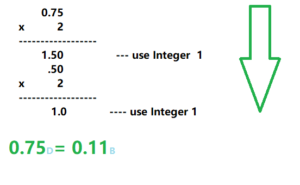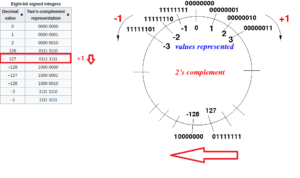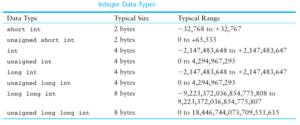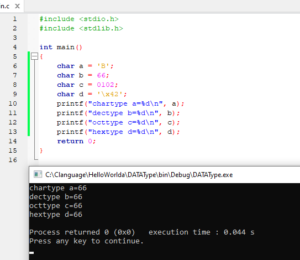Literals in C Programming refer to values that are directly specified in the code, rather than being stored in variables or calculated at runtime. Examples of literals include numeric constants like 42 or 3.14, character constants like ‘a’ or ‘\n’, and string literals like “Hello, world!”.

Literals are important in programming because they provide a way to represent values that are used in the code without having to store them in variables, which can be more efficient and convenient in some cases. Additionally, literals can be used to initialize variables with specific values or to compare variables with specific values.
1. Integer Literals
An Integer Literal is a value that represents a whole number in programming. In C programming, an integer literal can be expressed in decimal, hexadecimal, or octal notation.
There are three types of integer literals in C programming:
- decimal (base 10)
- octal (base 8)
- hexadecimal (base 16)
For example:
Decimal: 42, -11, 45 ... Octal: 041, 067, 043 ... Hexadecimal: 0x6F, 0x7F, 0x7AF ...
Integer literals can be used in various contexts, such as to assign values to variables, as parameters in function calls, or in mathematical expressions. They are an important part of programming, as they provide a way to represent numerical values directly in the code.
2. Floating-point Literals
Floating-point literals are values in programming that represent real numbers with a fractional part. In C programming, floating-point literals can be expressed in decimal notation or in exponential notation, where a number is represented as a coefficient multiplied by a power of 10.
For example:
-6.08 0.0000675 -0.11E-6
Floating-point literals are commonly used in mathematical calculations and scientific computations, where real numbers with decimal places are needed. It is important to note that due to the way floating-point numbers are represented in computers, they may not always be exact and may have some degree of imprecision or rounding errors.
3. Character Literals
Character literals in C programming are values that represent individual characters. They are specified using single quotes (‘ ‘), enclosing a single character. For example, the character literal ‘a’ represents the lowercase letter ‘a’, while the character literal ‘\n’ represents the newline character.
In addition to representing printable characters, character literals can also represent non-printable characters, such as control characters or escape sequences. For example, the character literal ‘\t’ represents the tab character, while the character literal ‘\0’ represents the null character.
Character literals are commonly used in C programming for tasks such as input and output of individual characters, character comparisons, and string manipulations. It is important to note that character literals are different from string literals, which represent a sequence of characters enclosed in double quotes (” “).
4. Escape Sequences
An escape sequence is a combination of characters that represents a special character, which cannot be represented directly in a string or character literal.
Escape sequences are used to represent special characters in strings or characters, such as the newline character (\n), the tab character (\t), the backslash character (), and the null character (\0), among others. These characters are considered special because they cannot be typed directly on the keyboard or represented in a character or string literal.
here’s a table with some of the commonly used escape sequences in C:
| Escape Sequence | Description |
|---|---|
| \n | newline character |
| \t | tab character |
| \r | carriage return character |
| \b | backspace character |
| \f | form feed character |
| \v | vertical tab character |
| ‘ | single quote character |
| “ | double quote character |
| \ | backslash character |
| \0 | null character |
Note that the escape sequence for each special character is represented by a backslash (\) followed by a specific character or combination of characters.
For example: \n is used for a newline.
5. String Literals
String literals in C programming are values that represent a sequence of characters enclosed in double quotes (” “). They are used to represent strings of characters, such as words, sentences, or even entire paragraphs.
For example:
"" " " "I am a good man" "Hello World!"
String literals are commonly used in C programming for tasks such as input and output of strings, string manipulations, and comparisons. In addition, they can be used to initialize character arrays, which are used to store sequences of characters in memory.
It is important to note that string literals are null-terminated, meaning that they are followed by a null character (‘\0’) to indicate the end of the string. This null character is automatically added by the compiler and is not included in the string literal itself.






